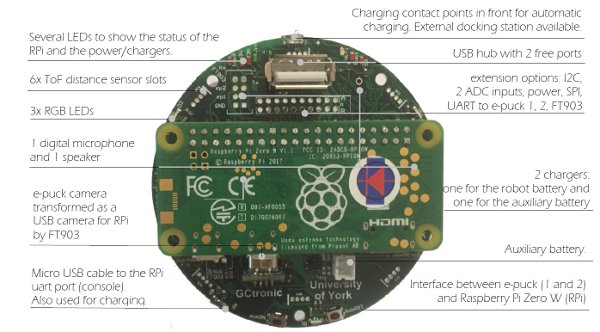Pi-puck: Difference between revisions
| Line 127: | Line 127: | ||
A Python example showing how to read data from the ToF sensor is available in the Pi-puck repository; you can find it in the directory <code>/home/pi/Pi-puck/e-puck2/</code>.<br/> | A Python example showing how to read data from the ToF sensor is available in the Pi-puck repository; you can find it in the directory <code>/home/pi/Pi-puck/e-puck2/</code>.<br/> | ||
You can run the example by issueing <code>python3 VL53L0X_example.py</code>. | You can run the example by issueing <code>python3 VL53L0X_example.py</code> (this is the example you can find in the repository [https://github.com/gctronic/VL53L0X_rasp_python/tree/master/python https://github.com/gctronic/VL53L0X_rasp_python/tree/master/python]. | ||
==Capture an image== | ==Capture an image== | ||
Revision as of 07:41, 26 September 2019
1 Overview
- Raspberry Pi zero W (rPi) connected to the robot via I2C
- interface between the robot base camera and the rPi via USB
- 1 digital microphone and 1 speaker
- USB hub connected to the rPi with 2 free ports
- uUSB cable to the rPi uart port. Also ok for charging
- 2 chargers. 1 for the robot battery and 1 for the auxiliary battery on top of the extension
- charging contact points in front for automatic charging. External docking station available
- several extension options. 6 i2C channels, 2 ADC inputs
- several LED to show the status of the rPi and the power/chargers
2 Getting started
This introductory section explains the minimal procedures needed to work with the Raspberry Pi Zero W mounted on the Pi-puck extension board and gives a general overview of the available basic demos and scripts shipped with the system flashed on the micro SD. More advanced demos are described in the following separate sections (e.g. ROS), but the steps documented here are fundamental, so be sure to fully understand them.
The extension is mostly an interface between the e-puck robot and the Raspberry Pi, so you can exploit the computational power of a Linux machine to extend the robot capabilities.
In most cases, the Pi-puck extension will be attached to the robot, but it's interesting to note that it can be used also alone when the interaction with the robot isn't required.
The following sections assume the full configuration (robot + extension), unless otherwise stated.
2.1 Requirements
The robot must be programmed with a special firmware in order to communicate via I2C bus with the Raspberry Pi mounted on the Pi-puck extension. The same I2C bus is shared by all the devices (camera, IMU, distance sensor, others extensions), the main microcontroller and the Raspberry Pi. Since the Raspberry Pi acts as I2C master, these devices will not be anymore reachable directly from the robot main microcontroller that will act instead as I2C slave.
2.1.1 e-puck1
The e-puck1 robot must be programmed with the following firmware pi-puck-e-puck1.hex.
2.1.2 e-puck2
The e-puck2 robot must be programmed with the following firmware e-puck2_main-processor_extension.elf (07.06.19) and the selector must be placed in position 10.
2.2 Turn on/off the extension
To turn on the extension you need to press the auxON button as shown in the follwoing figure; this will turn on also the robot (if not already turned on). Similarly, if you turn on the robot then also the extension will turn on automatically.
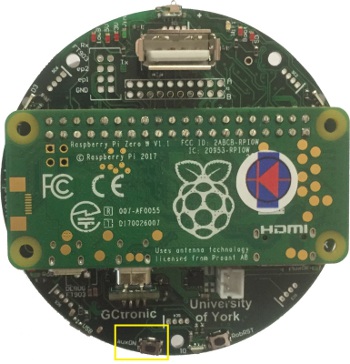
To turn off the robot you need to press and hold the auxON button for 2 seconds; this will initiate the power down procedure.
Beware that by turning off the robot, the extension will not be turned off automatically if it is powered from another source like the micro usb cable or a secondary battery. You need to use its power off button to switch it off. Instead if there is no other power source, then by turning off the robot also the extension will be turned off (not cleanly).
2.3 Console mode
The Pi-puck extension board comes with a pre-configured system ready to run without any additional configuration.
In order to access the system from a PC in console mode, the following steps must be performed:
1. connect a micro USB cable from the PC to the extension module. If needed, the drivers are available in the following link USB to UART bridge drivers
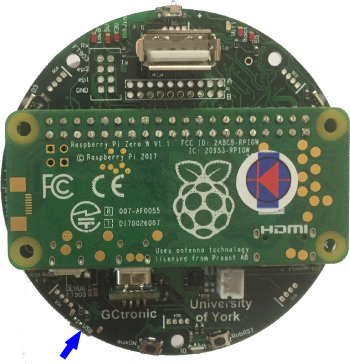
2. execute a terminal program and configure the connection with 115200-8N1 (no flow control). The serial device is the one created when the extension is connected to the computer
3. switch on the robot (the extension will turn on automatically); now the terminal should display the Raspberry Pi booting information. If the robot isn't present, then you can directly power on the extension board with the related button
4. login with user = pi, password = raspberry
2.4 Battery charge
You can either charge the robot battery or the additional battery connected to the Pi-puck extension or both the batteries by simply plugging the micro USB cable.
The following figure shows the connector for the additional battery.
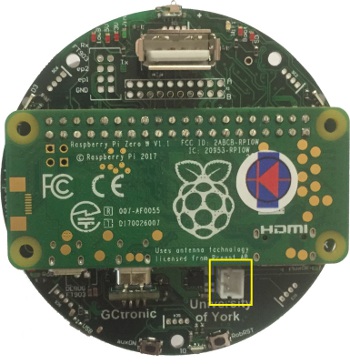
The robot can also autonomously charge itself if the charging wall is available. The Pi-puck extension includes two spring contacts on the front side that let the robot easily make contact with the charging wall and charge itself. The charging wall and the spring contacts are shown in the following figures:
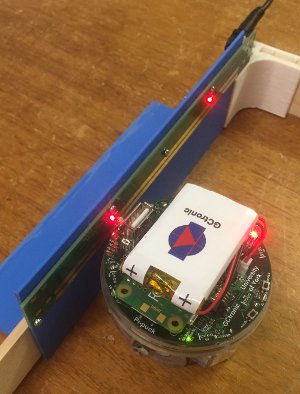
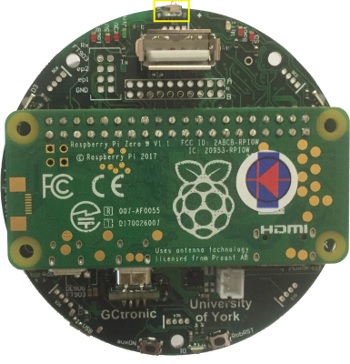
3 How to
3.1 Demos and scripts update
First of all you should update to the last version of the demos and scripts released with the system that you can use to start playing with the Pi-puck extension and the robot.
To update the repository follow these steps:
1. go to the directory /home/pi/Pi-puck
2. issue the command git pull
Then to update some configurations of the system:
1. go to the directory /home/pi/Pi-puck/system
2. issue the command ./update.sh; the system will reboot.
You can find the Pi-puck repository here https://github.com/gctronic/Pi-puck.
3.2 Communicate with the robot
3.2.1 e-puck1
Refer to the repo https://github.com/yorkrobotlab/pi-puck-e-puck1.
3.2.2 e-puck2
An example showing how to exchange data between the robot and the Pi-puck extension is available in the Pi-puck repository; you can find it in the directory /home/pi/Pi-puck/e-puck2/.
You can build the program with the command gcc e-puck2_test.c -o e-puck2_test.
Now you can run the program by issueing ./e-puck2_test; this demo will print the sensors data on the terminal and send some commands to the robot at 2 Hz.
3.2.2.1 Packet format
Extension to robot packet format, 20 bytes payload (the number in the parenthesis represents the bytes for each field):
| Left speed (2) | Right speed (2) | Speaker (1) | LED1, LED3, LED5, LED7 (1) | LED2 RGB (3) | LED4 RGB (3) | LED6 RGB (3) | LED8 RGB (3) | Settings (1) | Checksum (1) |
- Left, right speed: [-2000 ... 2000]
- Speaker id: [0, 1, 2]
- LEDs on/off flag: bit0 for LED1, bit1 for LED3, bit2 for LED5, bit3 for LED7
- RGB LEDs: [0 (off) ... 100 (max)]
- Settings:
- bit0: 1=calibrate IR proximity sensors
- bit1: 0=disable onboard obstacle avoidance; 1=enable onboard obstacle avoidance (not implemented yet)
- bit2: 0=set motors speed; 1=set motors steps (position)
- Checksum: Longitudinal Redundancy Check (XOR of the bytes 0..18)
Robot to extension packet format, 47 bytes payload (the number in the parenthesis represents the bytes for each field):
| 8 x Prox (16) | 8 x Ambient (16) | 4 x Mic (8) | Selector + button (1) | Left steps (2) | Right steps (2) | TV remote (1) | Checksum |
- Selector + button: selector values represented by 4 least significant bits (bit0, bit1, bit2, bit3); button state is in bit4 (1=pressed, 0=not pressed)
- Checksum: Longitudinal Redundancy Check (XOR of the bytes 0..45)
3.3 Communicate with the IMU
3.3.1 e-puck1
3.3.2 e-puck2
An example showing how to read data from the IMU is available in the Pi-puck repository; you can find it in the directory /home/pi/Pi-puck/e-puck2/.
You can build the program with the command gcc e-puck2_imu.c -o e-puck2_imu.
Now you can run the program by issueing ./e-puck2_imu and then choose whether to get data from the accelerometer or gyroscope; this demo will print the sensors data on the terminal.
3.4 Communicate with the ToF sensor
The Time of Flight sensor is available only on the e-puck2 robot.
First of all you need to verify that the VL53L0X Python package is installed with the following command: python3 -c "import VL53L0X". If the command returns nothing you're ready to go, otherwise if you receive an ImportError then you need to install the package with the command: pip3 install git+https://github.com/gctronic/VL53L0X_rasp_python.
A Python example showing how to read data from the ToF sensor is available in the Pi-puck repository; you can find it in the directory /home/pi/Pi-puck/e-puck2/.
You can run the example by issueing python3 VL53L0X_example.py (this is the example you can find in the repository https://github.com/gctronic/VL53L0X_rasp_python/tree/master/python.
3.5 Capture an image
The robot camera is connected to the Pi-puck extension as a USB camera, so you can access it very easily.
An example showing how to capture an image from the robot's camera using OpenCV is available in the Pi-puck repository; you can find it in the directory /home/pi/Pi-puck/snapshot/.
You can build the program with the command g++ $(pkg-config --libs --cflags opencv) -ljpeg -o snapshot snapshot.cpp.
Now you can run the program by issueing ./snapshot; this will save a VGA image (JPEG) named image01.jpg to disk.
The program can accept the following parameters:
-d DEVICE_ID to specify the input video device from which to capture an image, by default is 0 (/dev/video0). This is useful when working also with the Omnivision V3 extension that crates another video device; in this case you need to specify -d 1 to capture from the robot camera.
-n NUM to specify how many images to capture (1-99), by default is 1
-v to enable verbose mode (print some debug information)
Beware that in this demo the acquisition rate is fixed to 5 Hz, but the camera supports up to 15 FPS.
3.6 Audio recording
Use the arecord utility to record audio from the onboard microphone. The following example shows how to record an audio of 2 seconds (-d parameter) and save it to a wav file (test.wav):
arecord -Dmic_mono -c1 -r16000 -fS32_LE -twav -d2 test.wav
You can also specify a rate of 48 KHz with -r48000
3.7 Audio play
Use aplay to play wav files and mplayer to play mp3 files.
3.8 Battery reading
An example showing how to measure both the battery of the robot and the battery of the Pi-puck extension is available in the Pi-puck repository; you can find it in the directory /home/pi/Pi-puck/battery/.
The first time you need to change the mode of the script in order to be executable with the command sudo chmod +x read-battery.sh.
Then you can start reading the batteries value by issueing ./read-battery.sh.; this demo will print the batteries values (given in Volts) on the terminal.
3.9 WiFi configuration
Specify your network configuration in the file /etc/wpa_supplicant/wpa_supplicant-wlan0.conf.
Example:
ctrl_interface=DIR=/var/run/wpa_supplicant GROUP=netdev
update_config=1
country=CH
network={
ssid="MySSID"
psk="9h74as3xWfjd"
}
You can have more than one network parameter to support more networks.
3.10 File transfer
You can transfer files via USB cable between the computer and the Pi-puck extension by using on of the zmodem protocol.
The lrzsz package is pre-installed in the system, thus you can use the sx and rx utilities to respectevely send files to the computer and receive files from the computer.
Example of sending a file to the computer using the Minicom terminal program:
1. in the Pi-puck console type sx --zmodem fliename.ext. The transfer should start automatically and you'll find the file in the home directory.
Example of receiving a file from the computer using the Minicom terminal program:
1. in the Pi-puck console type rx -Z
2. to start the transfer type the sequence CTRL+A+S, then chose zmodem and select the file you want to send with the spacebar. Finally press enter to start the transfer.
3.11 Image streaming
3.12 Bluetooth LE
An example of a BLE uart service is available in the Pi-puck repository; you can find it in the directory /home/pi/Pi-puck/ble/.
To start the service you need to type: python uart_peripheral.py.
Then you can use the e-puck2-android-ble app you can find in chapter Connecting to the BLE in order to connect to the Pi-puck extension via BLE. Once connected you'll receive some dummy data for the proximity values and by clicking on the motion buttons you'll see the related action printed on the Pi-puck side. This is a starting point that you can extend based on your needs.
4 Operating system
The system is based on Raspbian Stretch and can be downloaded from the following link gctronic-stretch-ros-kinetic-opencv3.4.1.img.tar.gz.
When booting the first time, the first thing to do is expanding the file system in order to use all the available space on the micro sd:
1. sudo raspi-config
2. Select Advanced Options and then Expand Filesystem
3. reboot
4.1 Desktop mode
The system starts in console mode, to switch to desktop (LXDE) mode issue the command startx.
4.1.1 Camera viewer
4.2 I2C communication
The communication between the Pi-puck extension and the robot is based on I2C. The system is configured to exploit the I2C hardware peripheral in order to save CPU usage, but if you need to use the software I2C you can enable it by modifying the /boot/config.txt file and removing the # symbol (comment) in front of the line with the text dtparam=soft_i2c (it is placed towards the end of the file).
5 ROS
ROS Kinetic is integrated in the Pi-puck system.
5.1 Initial configuration
The ROS workspace is located in ~/rosbots_catkin_ws/
The e-puck2 ROS driver is located in ~/rosbots_catkin_ws/src/epuck_driver_cpp/
Remember to follow the steps in the section Requirements and section Demos and scripts update, only once.
The PC (if used) and the Pi-puck extension are supposed to be configured in the same network.
5.2 Running roscore
roscore can be launched either from the PC or directly from the Pi-puck.
Before starting roscore, open a terminal and issue the following commands:
export ROS_IP=roscore-ipexport ROS_MASTER_URI=http://roscore-ip:11311
where roscore-ip is the IP of the machine that runs roscore
Then start roscore by issueing roscore.
5.3 Running the ROS node
Before starting the e-puck2 ROS node on the Pi-puck, issue the following commands:
export ROS_IP=pipuck-ipexport ROS_MASTER_URI=http://roscore-ip:11311
where pipuck-ip is the IP of the Pi-puck extension and roscore-ip is the IP of the machine that runs roscore (can be the same IP if roscore runs directly on the Pi-puck).
To start the e-puck2 ROS node issue the command:
roslaunch epuck_driver_cpp epuck_minimal.launch debug_en:=true ros_rate:=20
The following graph shows all the topics published by the e-puck2 driver node:
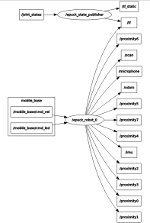 Click to enlarge
Click to enlarge
5.4 Get the source code
The last version of the e-puck2 ROS node can be downloaded from the git: git clone -b e-puck2 https://github.com/gctronic/epuck_driver_cpp.git
6 OpenCV
OpenCV 3.4.1 is integrated in the Pi-puck system.
